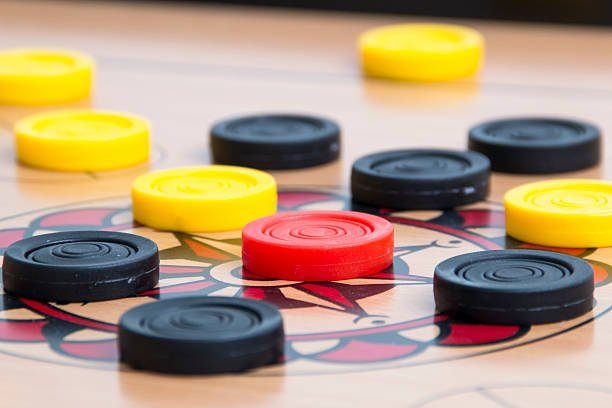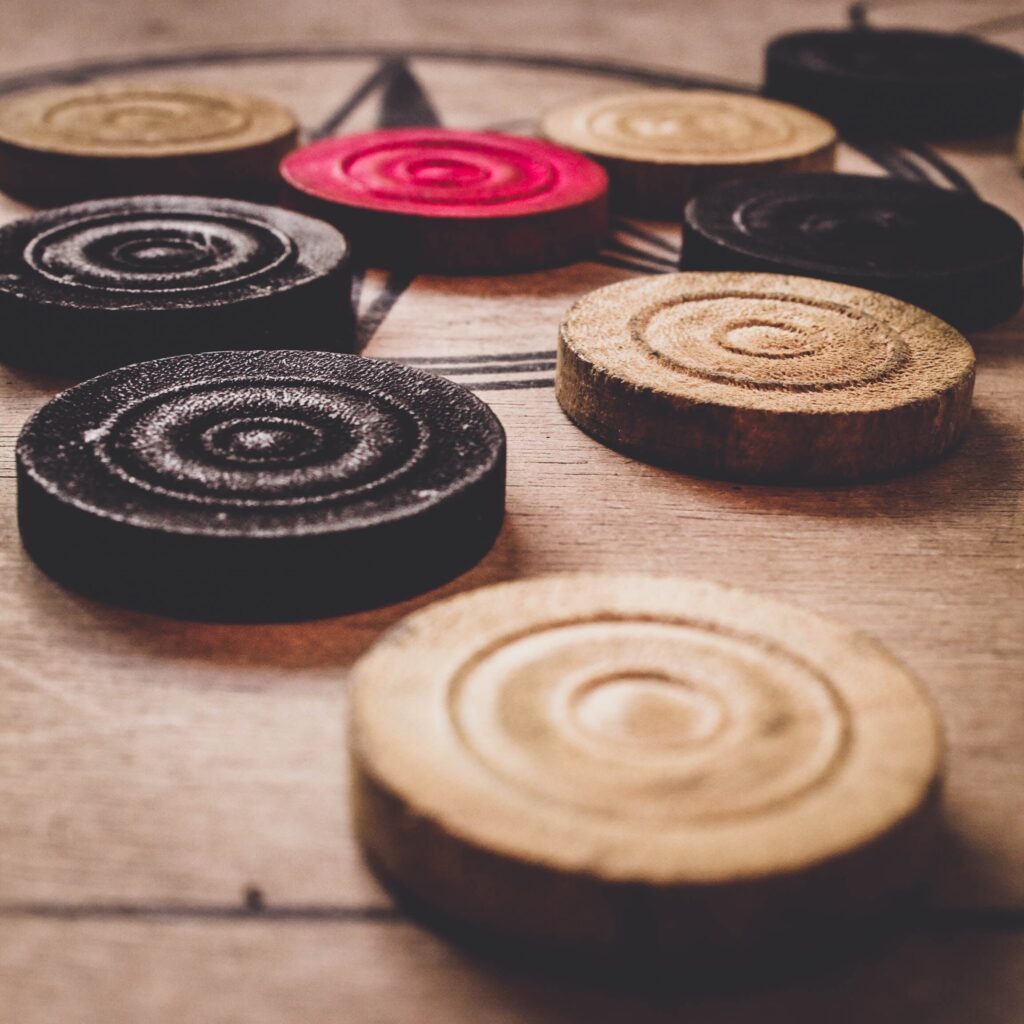
Carrom rules have raised many questions in the minds of people. It’s great to hear how excited people are about playing carrom. So if you want to know carrom rules, it is exigent to know what carrom is?
Let’s know what carrom is all about.
Table of Contents
What is Carrom?
It is an indoor game. Besides playing online, you can also play it offline. We all know that it has probably been exciting for over two centuries. There is a belief that it originated in India.
Meanwhile, some people think it is associated with Portugal and even Myanmar. It played on a wooden square board with some necessary equipment.
No. of Players in the Carrom
You may wonder now, does it start with a player like in tennis or football?
Now, we take a close look at the Carrom player. A Carrom board usually accommodates four players. When four players play together, it is called doubles in carrom.
In doubles, two teams play a total of four against each other. Also, a total of two or three people go to play carrom.
Can anyone play carrom for India?
The first thing you need to do is join your district carrom association. Then you have to stamp your authority at the district level. As a result, you moved to the senior category.
Your next step is to win the Senior level and maintain your district ranking. You will be allowed to represent your district in the state tournament if you rank well in your district.
You are qualified to participate at the national level as soon as you win your state tournament and retain your state rating. After winning in the Nationals, the flood gate will be open for you.
You can represent India at international standards.
Governing Body
ICF (International Carrom Federation) is the international organization that governs the game of carrom. ICF is an association that was founded in Chennai, India, in 1988, governed by Swiss law.
At present, the headquarters are in Zurich, Switzerland. It focuses on leading and promoting carrom globally.

Carrom Rules
Now, we come to the main point. There are many rules in carrom that I will discuss right now.
Position Of Sitting Rules
- Each player in a doubles match sits opposite the other on each side.
- Players should sit opposite each other in singles.
- Before the turn of the strike, players can change their seating positions at any time.
- In addition, players may not touch or obstruct any indirect equipment with any part of their bodies. Only his playing hand can touch the board.
- A player may not use any personal accessories during the game. It is possible to have a maximum seat height of 50 cm.
- A player may not cross any imaginary lines of the arrows except with their hand.
Rules in Toss
- Each match shall start with an umpire’s toss. The toss is done by tossing coins or calling carrom pieces. After winning the toss, either player/pair could choose their side or strike first. The winning party must inform the umpire of his/their decision, and he/they will instruct the loser to sit earlier.
- If the winner of the toss chooses the break, the loser will have the right to decide the side, and the winner will have to sit first.
- Losers cannot exchange seats once they have sat down. It will remain the same throughout the match.
Carrom Board Rules
- During the match, position of C/B cannot be changed.
- Changing the C/B, stand, or table assigned for a match can only be done by finishing the board.
- Dust, insects, etc., should be removed from the C/B during play by the umpire.
- Players must not intentionally damage the C/B, tap it or disturb it in any way.
Note: Here C/B denotes the Carrom Board.
Carrom Pieces Rules
- The umpire should replace any damaged C/P in the original position of the damaged C/P if the appeal is for replacement.
- In situations where a player knowingly or unknowingly pockets the C/P of their opponent, the umpire should stop them from continuing the game.
- The umpire will have the final say in the case of a C/P that is damaged.
- During the match that C/P is lying on the baseline/base circles, the board may reappear if the player is unable to take a stroke.
- It is valid for the C/P to enter the pocket without the attention of the opponent and the umpire.
- If any C/P comes out of the carrom board, the umpire will place it in the middle of the board.
- If a queen and a C / P jump at the same stroke, place the queen first, then place the C / P on the opposite side of the active turn player with the queen.
- Although both C/P will leave C/B, the C/P of the player with the stroke will be placed first, then another C/P will be placed by touching the first.
- When C/P or queen stands on the rim, it shall be allowed to remain this way.
- The C/P and queen shall remain undisturbed if they overlap.
- The C/P and queen may be considered pocketed when their center of gravity is lost in removing the striker.
Note: Here C/B denotes Carrom Board, and C/P refers to Carrom Pieces.
Rules of the Striker
- The striker must touch both Base Lines when taking a stroke.
- The player will be able to use striker only after certifying the umpire.
- If a player pockets any C/P or queen while the striker jumps over the C/B, the player shall continue to strike.
- You can change the damaged striker in the middle of the board after finishing the stroke.
- The striker should be removed immediately from the C/B after the stroke.
- An opponent must not pick up his striker before the player strikes.
- If the striker slips from any Base Line or Base Circle, even without touching any C/P, it is considered a stroke.
- The striker must cover the Base Circle fully but not touch the Arrow in taking the stroke.
- The run test of striker within the course of a Board is not allowed.
- A player may not keep the striker in the pocket or on the frame of the C/B during a Board.
Note: Here C/B denotes Carrom Board, and C/P denotes Carrom Pieces.
Rules of Break
- Before the break, the C/Ps occupy the circle centering on the queen in the center circle.
- It is essential to plan the break with the least possible time loss after each board. A player strikes first for the break.
- Even the slightest touch by the striker on any of the C/P is considered a break.
- It is not considered being a break if the striker does not touch any C/P during its usual run or jump out. The striker then has two more chances.
- Players who pocket their striker before touching the C/P or play an improper stroke in their attempt to break will lose their turn. There will be no due/penalty.
- It is mandatory to break after the umpire calls ‘play’ and to stroke within 15 seconds after such a call.
Note: Here C/P denotes Carrom Pieces.
Rules For Covering the Queen
- Players may pocket and cover the queen only if they have already pocketed at least one piece of their color.
- When another C/P partially or fully covers the center circle, the queen should be positioned so that it fills the majority of the uncovered area. On the other hand, it is in the center circle, making it difficult for the player to pocket it on his turn.
- Players who pocket the queen with a Due against them would be removed for placing, and the player would lose that turn.
- Even so, a player has the right to pocket and cover the queen after recovering the penalty.
- The queen shall be considered covered if it is pocketed in conjunction with the C/P of a player in one stroke.
Note: Here C/P denotes Carrom Pieces.
Rules of Dues and Penalty
- Whenever a player pockets his striker alone with a proper stroke, he loses his turn, and one of his C/P will be taken out as a penalty by his opponent. This type of penalty is known as Due.
- An improper stroke will result in the player losing his turn, and his opponent will be placed by taking two of his C/P out. It is called Due and Foul. When the opponent cannot do this before the beginning of the next turn, any owed penalties are forfeited.
- If this happens before it goes into any of his C/P pockets, a penalty and arrears will apply, and they will be taken out once C/P is available.
- A player may place a Due or Penalty C/P if space is available but not sufficient to be placed. If space becomes available, however, the player may place the C/P.
- However, in Doubles, a partner shall have the right to place or take out a C/P only if the eligibility to place the Due or penalty C/P has passed to them.
- By mistake, if an umpire or opponent points out a player’s own C/P while placing the Due or penalty C/P, it has to be corrected immediately. According to the Laws, a foul must be declared.
- If the C/P placed is inside the Outer Circle, then the placement is considered complete once the finger has been removed from the C/P.
- A player violates the rules of striking.
- The player touches any other piece in play except the striker.
- After three attempts, the first player to strike does not break the counters.
Note: Here C/P denotes Carrom Pieces.
Additional Rules
- It is advisable to use powder sparingly but not excessively.
- After the announcement of play by the umpire, no powder shall be applied or removed.
- There shall be no deliberate attempt to wipe or remove powder from the playing surface.
- There are 25 points in a match or eight boards. If a player cannot score 25 points on eight boards, then the player with the most points will win.
- The player or team must be present at the right time.
- Teams should arrive 5 minutes before the scheduled event time. Within those 5 minutes, players can test the boards for two minutes and start their matches on time.
- There will be no trial boards.
- Players will have a 10-second time limit for making a stroke and for placing dues/penalties.
- During the second and third games, players may rest for two minutes.

My name is Krishanu Das the founder of the Sports Dribble.
I am Accountant by profession but a Sports Blogger by passion.
I am passionate about sharing my all knowledge and experiences of sports, with my readers and every sports enthusiast.
Discover more from SPORTS DRIBBLE
Subscribe to get the latest posts sent to your email.

